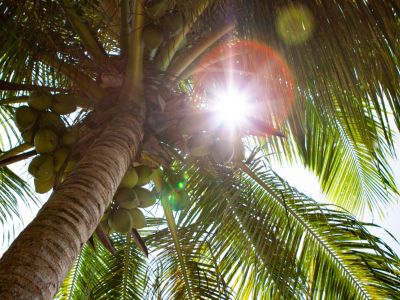Help, My Coconut Fruit is Wilting!
If you are lucky enough to have a coconut tree in your landscape, you may witness coconut fruit tree wilting. What might be some reasons for a wilting coconut and are there any methods for treating a wilting coconut tree? The first order of business is to figure out why the coconut is wilting. As mentioned, the weather may be a consideration. Not just overly cold temps, but plants — especially young palms, can get sunburned, which will adversely affect foliage. Arid conditions with low humidity levels will also cause wilting. Provide adequate protection from the fierce sun when the plant is immature and give the palm plenty of water, especially during the growing season. Basically, avoid stressing the palm. Coconut palms that do not get enough nutrients are more susceptible to coconut palm diseases. Use a high-quality, slow-release fertilizer that won’t be washed away with the rain. Fertilize coconut palms during their growth period four to five times per year. To avoid burning the trunk, keep the fertilizer 2 feet (0.5 m.) out from the tree.
Caring for Sick Coconut Trees
There are a number of diseases that may afflict a coconut palm that may cause wilting, but caring for sick coconut trees is not always an option. Sometimes treating a wilting coconut tree means it is best to remove the tree and destroy it. Many fungi and diseases can infect the surrounding area for long periods of time, so it is often better to leave the area to fallow, or remain unplanted, for at least a year.
Ganoderma butt rot – Ganoderma butt rot causes older fronds to turn yellow, gradually wilting and eventually dying off. This fungus enters the tree through wounds on the trunk often caused by over-enthusiastic pruning or damage from machinery; space trees widely to avoid damaging them with machinery. If the tree is infected with the disease, it is best to fallow the area for at least a year. Lethal bole rot – Lethal bole rot is another fungus that also causes yellowing and wilting in the oldest fronds combined with a reddish-brown rot in the bole tissue and eventual destruction of the entire root system. A possible host for this fungus may be some types of grasses, specifically Bermuda grass. Be sure to maintain a clear area surrounding the palm to avoid infection. If the tree is infected, remove it and destroy it, then treat the area. Fusarium wilt – Fusarium wilt causes progressive wilt and eventual death of the fronds. Often one side of the tree wilts. Brown streaks can be seen at the base of the petiole with brown vascular tissue. There is much conjecture about how this disease is spread. It is possible that it is through the use of infected pruning tools. Prevention includes proper sanitation and conservative leaf pruning with sanitized tools. Fusarium wilt is a soil-borne pathogen; therefore, there may be spores in the soil. If you have a tree you suspect has succumbed to Fusarium wilt, do not replant a new palm in the infected area.
Palms that are damaged from cold or other mechanical or environmental issues should be treated with copper fungicide to protect them from bacteria and fungi. For further assistance with treating a wilting coconut palm, check with your local Extension office.
